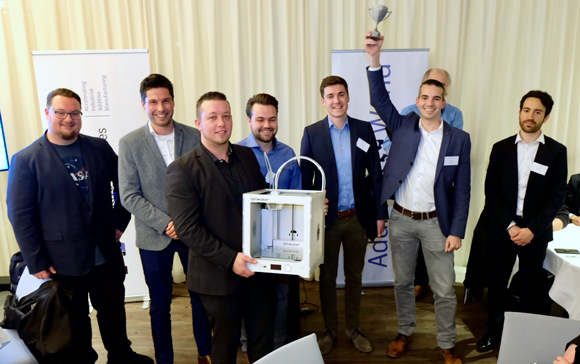Winners of Design for Additive Manufacturing Challenge 2019 announced
March 21, 2019

The winners of the Design for Additive Manufacturing Challenge 2019 (Courtesy Additive Industries)
Additive Industries, Eindhoven, the Netherlands, announced the winners of its Design for Additive Manufacturing Challenge 2019 during the awards dinner of the 7th edition of the Additive World Conference, held at the company’s High Tech Campus in Eindhoven, March 20–21. K3D, in the professional category, and Obasogie Okpamen, in the student category, received first prize for their metal additively manufactured dough cutting knife and twin spark engine connection rod, respectively.
Obasogie Okpamen is a student at The Landmark University, Omu-Aran Kwara State, Nigeria. For his entry, Okpamen redesigned a connection rod for an Alfa Romeo 75 Twin Spark Turbo engine. Although the design was not completely tested yet, the jury stated that they had appointed him winner “because of the example it set.”
Large amounts of used cars that are written off in Europe are shipped to Africa for a ‘second life’. This results in a high demand for spare parts to sustain this life. This relatively simple application shows a huge potential in the spare parts market. According to Okpamen, Additive Manufacturing allows for distributed localised manufacturing of spare parts in many more categories than the automotive after-market.
K3D, the Netherlands, presented a dough cutting knife developed for bakery equipment manufacturer Kaak Group, which is also its parent company. This real-world product and case study combines a high number of the advantages of metal Additive Manufacturing, such as weight reduction, part count reduction, porous structures, integrated channels, increased performance and substantial cost reduction, with a very practical and original application.
The business case for this part is believed to be very strong, especially because of the weight savings it offers, which result in higher moving speeds for the knives, saving two out of eight robots in a production line. Further, the jury was reportedly impressed by the integration of mechanical parts, spring leaf and bearing, and the fact that it was designed specifically for AM.
In addition, the part requires no support structures during Additive Manufacturing, and even the threads for the interface with the robot are additively manufactured and able to be used without post-machining. Finally, the porous knife blade, created using a custom parameter set, is said to improve functionality by creating an air shield around the blade.
All finalists in the Design for Additive Manufacturing Challenge 2019 received a free one-year licence for Altair Inspire and Autodesk Netfabb software. Obasogie Okpamen, as student winner, received an Ultimaker 2+ polymer 3D printer, while the K3D team won an Ultimaker 3.
















